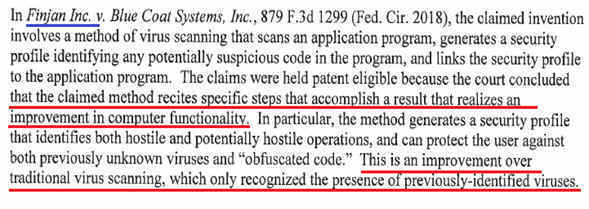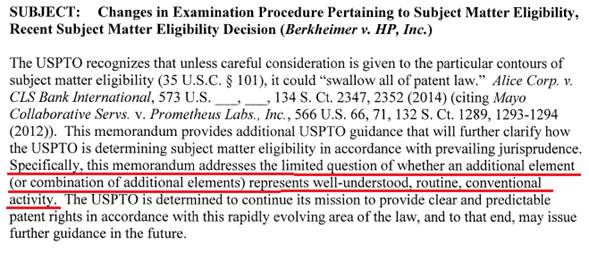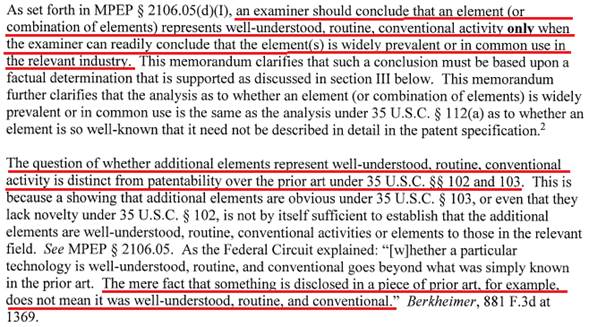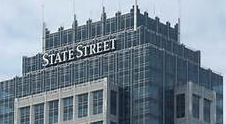
|
What’s Going on
with Eligibility Examination under 101? 101条審査に対して 米国特許庁の状況は? Summarized by Tatsuo YABE –
2018-04-20 |
|
101条の現状(2018年4月20日時点):
暫くの間、101条審査に関して沈黙していた米国特許庁(以下USPTOと称する)が4月にはいり101条の特許保護適格性審査に関する2件のMemorandumを審査官に通知した(2月8日にUSPTOのDirectorに就任されたIancu氏によるものか・・・?)。
|
2018年4月2日のメモランダムではFINJAN判決とCore-Wireless判決(共に2018年1月のCAFC判決)を基に101条審査に言及した。これら2件の判決に共通するには従来技術に対して特定の改良を齎すことにクレームの構成要素がリンクしている場合には101条を満たすという点である。尚、2018年4月19日のメモランダムではBerkheimer判決(2018年2月のCAFC判決)を基にAlice第2ステップ(USPTOのステップ2B)の判断時に問題となるクレームの構成要素が当業者にとって、当然のごとく理解され、ルーチンで、一般的な行為
(“well-understood, routine,
conventional” activity)であるか否かを判断する基準は102条の基に先行技術になるからというレベル以上に当業者にとって広く知れ渡っているというレベルの場合であることを周知徹底している(例:ドイツの大学の図書館で眠る一冊の論文も102条の基には先行技術となりうる。しかし当業者にとって広く一般的に知られていたとは言えない)。しかし、4月19日のメモランダムで取り上げられたBerkheimer判決においても保護適格性が認められたクレームは従来例の問題点を解決する(即ち、従来技術に改良を齎す)構成要素がクレームに記載されているか否かが判断基準となった。
|
昨今のCAFC判決(101条関連)及びそれに対応(反応)するUSPTOの101条審査の指針(各々の審査官に周知徹底されるには時間を要するであろうが)を見る限り、101条審査と新規性/進歩性審査が重なり合う部分が顕著化していると理解される。少なくとも特許保護適格性の認定に対しては最高裁(2010年のBilskiで始まり2014年のAlice判決)が混乱させてことは否めないがCAFC(及びUSPTO)は最高裁が厳格な方に振りすぎた101条の振り子を2010年のBilski判決前に戻そうとしているように理解される。2008年のBilski大法廷判決(2010年のBilski最高裁判決の前)においてCAFCは自身の1998年のState
Street Bank事件で判示した101条判断テスト(“Useful-Concrete-Tangible Result" (UCTR)
test を否定した。即ち、UCTRテストとは、ビジネス手法であるからといって101条の適格性を否定されるものではなく、クレームの構成要素によって現実の世の中に具体的な効果をもたらす場合には101条を満たすという趣旨だった。「現実の世に具体的な効果を齎す」とは従来技術の問題を解決する(従来技術に改良を加える)ということにほかならない。重要なのはクレームの構成要素が「現実の世に具体的な効果を齎す」ということに直接リンクしていることだ。
|
尚、2018年2月8日にUSPTOのDirectorに就任されたIancu氏(前職はIrell
& ManellaというIP法律事務所の特許弁護士)によると米国特許において現在2つの不確定な要素があり、そのうちの一つが101条の保護適格性の判断基準である。USPTOが最高裁の101条関連の判決を尊重するのは当然の義務ではあるが、USPTOとしてできる限り101条の審査基準を明確なものにしてゆきたいという意向を述べている(4月11日の米国商工会議所にて所信演説)。実務経験も長いIancu氏の登場はKappos氏時代を思い起こさせる。USPTOの101条審査基準の構築に関してIancu氏に期待したい。
[以上筆者]
|
------------------------------------------------------------------
USPTOは4月2日付で、Finjan判決(2018年1月10日)及びCore-Wireless判決(2018年1月25日)に鑑み審査官にメモを通知した。当該メモで、これら2件の判決の概要を説明し、2018年1月29日に更新された審査便覧(MPEP2106)との整合性があることを通知した。当該メモにおいて、Finjan判決とCore-Wireless判決は共にソフトウェア関連発明でありコンピューター技術の改良に照準を合わせた発明をクレームしており、依ってAlice第1ステップでAbstractアイデアを対象とするものではないと述べた。
|
特記すべきは、FINJAN判決の要約部を引用し、以下のように述べている。
|
The claims were held patent eligible because the court concluded that the
claimed method recites specific steps that accomplish a result that
realizes an improvement in computer functionality. ……… This is an
improvement over traditional virus scanning, which only recognized the
presence of previously-identified viruses. |
クレームされた発明はコンピューターの機能を改善する結果を実現するための特定のステップを規定している。・・・さらにそれは従来技術では既に認識されたウイルスの検出しかできなかったという従来のウイルス検出から改良されたものだ。 |
|
さらに、Core Wireless事件の要約部を引用し、以下のように述べている。
|
In particular, the claims contain precise language delimiting the type of
data to be displayed and how to display it, thus improving upon
conventional user interfaces to increase the efficiency of using mobile
devices. |
特に、クレームはどの種のデータを表示するのか、及び、どのように表示するのかを特定する明確な用語を含んでおり、ユーザーとのインターフェースに改良を齎し、従前の携帯装置(電話)をより効率的に使える。 |
|
4月2日のメモランダムに続き、USPTOはBerkheimer判決(2018年2月8日)に鑑み審査官にメモを通知した。Berkheimer事件においては、101条判断においてクレームのある構成要素が当業者にとって当然のごとく理解され、ルーチンで、一般的な行為
(“well-understood, routine,
conventional” activity)であるか否かに関して論争がある場合、それは事実判断であり、略式裁判で判断してはならないとした。Berkheimer事件で問題となった特許はディジタル資産管理システムにおけるファイルのディジタル処理とその記録と保管に関する発明で、明細書では共通のテキスト及び図式情報を重複記録するのを避けることで、システムをより効率よく運用し、且つ、記憶容量を減らすことでコストを削減すると説明している。同CAFC判決においてUSP744713のクレーム1-3及び9は目的とされた改良を実現するための特徴がクレームに記載されていないとして101条を満たさないと判断したが、クレーム4-7に関しては当該目的を達成するための特徴がクレームに記載されているとして101条を満たすと結論づけた。
尚、USPTOのメモランダムにおいて審査官が、クレームの構成要素を
well-understood,
routine, conventionalであると結論づける場合には、当該構成要素が、問題となる発明が関連する技術分野において広く行き渡っている、或いは、一般的に使用されている場合のみとすることを強調している。即ち、102条の基に刊行物となるからという理由のみで”well-understood,
routine, conventional”なものとは限らないことを言及している。例えば、102条の基にはドイツの大学の図書館に眠る唯一の論文であっても刊行物となる、しかし、それは
well-understood, routine, conventionalなものではない。さらに審査官がOfficial
Notice(刊行物など証拠を一切特定せずに当然のことであると行政庁として通知すること:例、富士山は3000メートルより高い)を宣言する場合には、それなりの知見に基づき適切と思える場合にのみ実行すること。
|
*****************************************
|
References:
|
[1]
2018-04-02 USPTO’s Memorandumの要部:





|
[2]
2018-04-19
USPTO’s Memorandumの要部:

|

|
[3]
State Street Bank & Trust v.
Signature Financial Group (Fed. Cir. 1998),

The district court held the patent
invalid as directed to nonstatutory subject matter. The Federal Circuit
reversed, however, in an opinion that was followed by a large increase in the
issuance of business-method and software patents.
“Useful-Concrete-Tangible
Result" (UCTR) test
[T]he transformation of data,
representing discrete dollar amounts, by a machine through a series of
mathematical calculations into a final share price, constitutes a practical
application of a mathematical algorithm, formula, or calculation, because it
produces "a useful, concrete and
tangible result"—a final share price momentarily fixed for
recording and reporting purposes and even accepted and relied upon by regulatory
authorities and in subsequent trades.
|
[4]
REMARKS by
Director Andrei IANCU at US Chamber of Commerce PATENT POLICY
CONFERENCE – 2018-04-11(抜粋)
|
|
Andrei Iancu氏:1968年生まれ 2018年2月8日付けでUSPTOのDirectorに就任: Iancu
was nominated by President Trump on August 26, 2017; approved by the
Senate Judiciary Committee on December 14, 2017; confirmed by the Senate
94-0 on February 5, 2018; and assumed the offices of Under Secretary and
Director on February 8, 2018, when he was sworn in. |
|
……..So your report identifies two principal reasons for the increased uncertainty (or lower reliability) of our patents:
|
1. Patentability Standards, or more specifically, patent subject matter eligibility pursuant to 35 USC Section 101; and
|
2.
Opposition procedures, namely, the post-grant procedures, such as IPR, that were
established by the America Invents Act.
|
Let me
address each of these in turn.
|
First,
our current law surrounding patentable subject matter has created a more
unpredictable patent landscape that is hurting innovation and, consequently,
investment and job creation. Recent cases from the Supreme Court – Mayo,
Myriad, and Alice – have inserted standards into our interpretation of the
statute that are difficult to follow. Lower courts applying these cases are
struggling to issue consistent results. Patent lawyers trying to advise their
clients are, in turn, struggling to predict the outcome with respect to certain
patents. And examiners at the USPTO must spend increased amounts of time
addressing this challenging issue. The current standards are difficult for all:
stakeholders, courts, examiners, practitioners, and investors alike.
|
System-wide,
a significant amount of time is being spent trying to figure out where the lines
should be drawn, and what’s in and what’s out. And multiple people looking
at the same patent claims often have trouble agreeing on, and predicting, the
outcome. Something must be done. To be
sure, we must and will apply Supreme Court law faithfully. This
does not mean, however, that more cannot be done to increase clarity and
predictability. Of course, given our statutory mandate, there is only so much
that the USPTO can do. But within that mandate, we will do everything we can. Currently,
we’re actively looking for ways to simplify the eligibility determination for
our examiners through forward-looking guidance.
Through
our administration of the patent laws, which we are charged to execute, the
USPTO can lead, not just react to, every new case the courts issue.
|
Second,
your report also mentions our “patent opposition procedures” as a reason for
the increased uncertainty of our patents. This refers primarily to our Inter
Partes Review, or the IPR system. This was a creation of the America Invents
Act, and since its introduction five and a half years ago, we have now conducted
more than 8,000 such proceedings. It’s been a very popular proceeding.
Opinions on this new system diverge widely. Yet each opinion is passionately
held by its supporters. Pointing to the high invalidation rates in IPR
proceedings, some hate the new system with vigor, arguing that it’s an unfair
process that tilts too much in favor of the petitioner.
|
|
(5) LINKS |